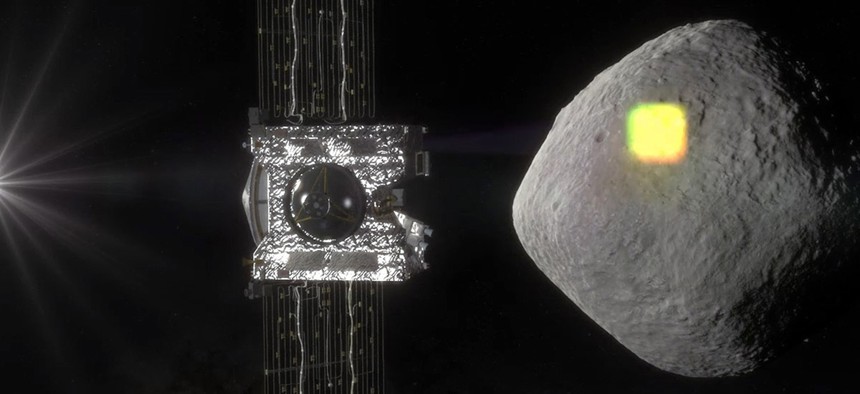NASA Is Launching a Mission to Visit an Asteroid and Maybe Save the World

This artist's rendering made available by NASA in July 2016 shows the mapping of the near-Earth asteroid Bennu by the OSIRIS-REx spacecraft. NASA/AP
The ambitious OSIRIS-REx mission promises to provide new information about our universe to the scientific community.
If all goes according to plan, a NASA spacecraft will slip the surly bonds of Earth tonight to punch the face of an asteroid four years hence.
The ambitious OSIRIS-REx mission promises to provide new information about our universe to the scientific community, and further proof-of-concept for commercial asteroid miners aiming to harvest precious resources in space.
The mission’s founding father, pioneering NASA scientist Michael Drake, passed away in 2011, shortly after his plan was approved. He hoped visiting an asteroid that has plied the universe for centuries would help answer questions like, “What’s the origin of the organic material that provided the building blocks that led to life?”
The asteroid target, Bennu, orbits around the sun, and was chosen because of its size, just over 500 meters in diameter; its carbon-heavy composition, assessed by many observations from Earth, means it is more likely to contain organic matter; and its nearness to our planet.
Indeed, it may perhaps be too near: The asteroid could come close enough to Earth to disastrously impact it sometime in the 22nd century. NASA’s mission planners say that understanding more about Bennu could prepare future generations to prevent such an outcome by diverting or destroying it.
The $800 million spacecraft’s complicated name is not just a weird concatenation of ancient Egyptian and Latin that suggests “God-King of the Dead.” It’s an acronym—which the team says emerged spontaneously—that spells out the mission:
Origins—Analyze the asteroid’s material composition to learn more about the development of the universe.
Spectral Interpretation—Compare close-up data on the asteroid to our telescopic measurements so we can better calibrate them.
Resource Identification—Figure out what materials make up the asteroid.
Security—Attempt to measure what about the asteroid’s composition is making it orbit dangerously close to Earth.
REx—”Regolith explorer”: the surface material of an asteroid is called regolith, and this mission will retrieve samples and bring them back.
It will take two years for OSIRIS-REx to simply catch up with Bennu as it travels the solar system. Once it does, by August 2018 according to plan, it will move into orbit around Bennu and use its sensors to comprehensively image and scan the surface of the asteroid for another year or two. Then, all that data in hand, the probe’s software will determine the best place for Bennu to take a sample around July 2020.

The sampling will not involve a proper landing, as Philae, the European Space Agency probe, did on a comet in 2014, where it still remains. It’s more like a grabber claw at an arcade—OSIRIS-REx will head near to the surface and deploy a special tool. The tool will hit the regolith for just 5 seconds, firing out a burst of nitrogen gas to suck material up into the spacecraft without contaminating it.

The spacecraft will carry enough nitrogen for three 5-second dips, and then the sampling is over. The hope is to get at least 60 grams of material—”four tablespoons of packed brown sugar,” in the words of Christina Richey, a NASA scientist working on the mission. That may seem small, but it will also be the largest sample of space material returned to Earth since the Apollo moon missions. Assuming all goes well, OSIRIS-REx will start its return trip in 2021 and arrive back on planet in 2023, samples in tow.
Even before it returns, a successful mission could help fledgling asteroid mining concerns prove that their ideas have merit.
“OSIRIS-REx is an exciting mission, both for helping us better understand the secrets of the Solar System, as well as measuring the important resources which may be present in [carbon-based] asteroids like Bennu,” Chris Lewicki, the president of Planetary Resources, said in an email. “Water for life support, radiation shielding for human travels, and rocket fuel for future space explorers are all resources available from these types of asteroids.”






